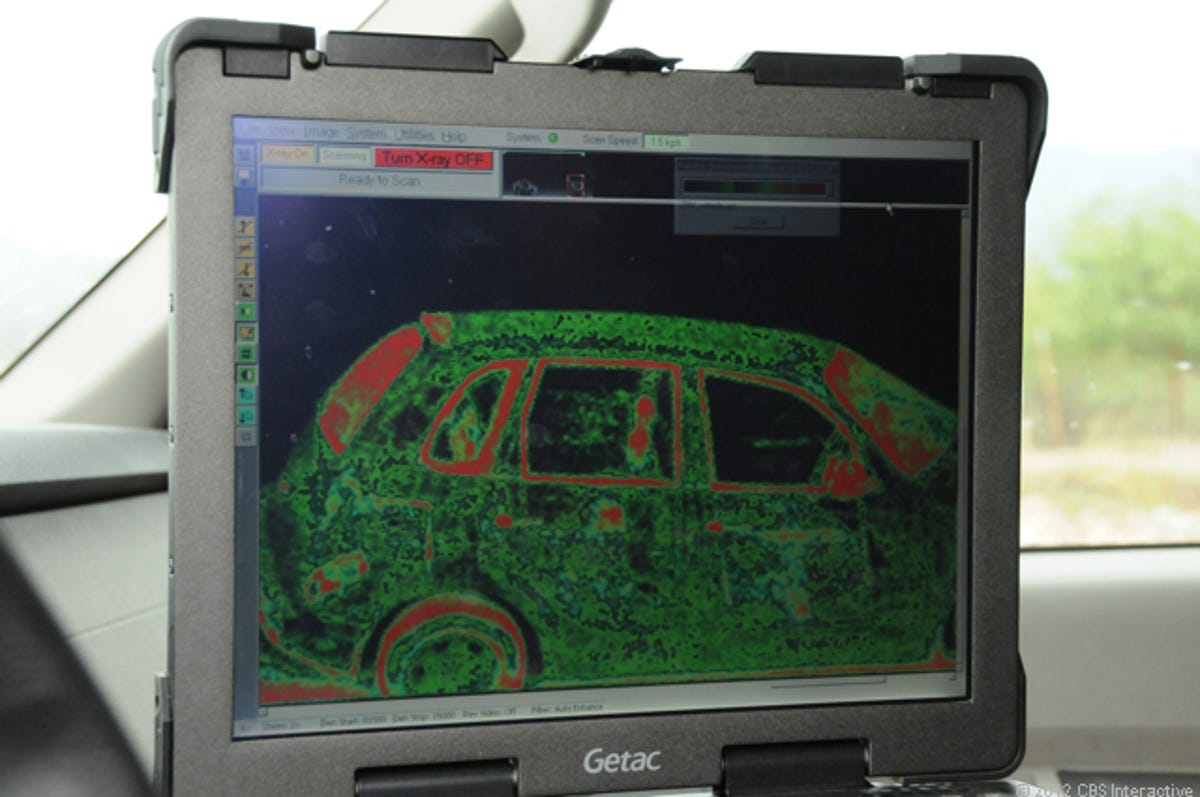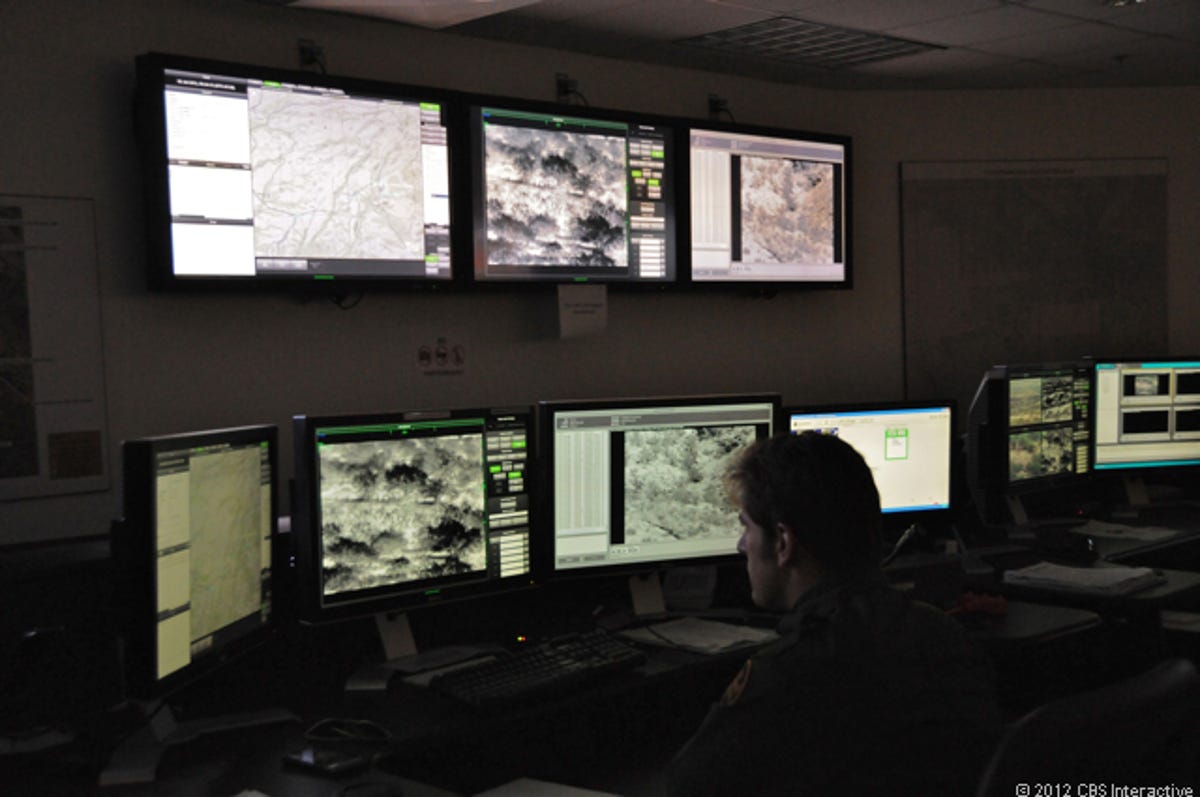Tech looms large in Arizona border battle with smugglers (pictures)
The U.S. Border Patrol uses technology of all kinds -- multiple cameras, underground sensors, radar, infrared, and more -- to protect the Arizona desert against illegal activity. CNET spent a day checking it out.

PT Cruiser in green
TUCSON, Ariz.--Arizona's long desert border with Mexico is one of the hottest in the nation. Every day the temperature tops a hundred, and every day, the U.S. Border Patrol catches more than 300 people attempting to sneak into the U.S. Many are smugglers responsible for significant cargo -- often migrants or narcotics.
To combat the never-ending flow of smuggling, the Border Patrol operates a complex network of automated sensors -- cameras and underground motion detectors -- in conjunction with air and mobile vehicle-based surveillance, and significant legwork, both in control rooms in Tucson and often on foot in the desert.
There are also checkpoints all over the place, and at the biggest ones, like one along Interstate 19 -- south of Tucson, just north of the Nogales port of entry -- the Border Patrol operates "non-intrusive" technology like a backscatter truck that can scan vehicles looking for organic matter -- people or drugs certainly qualify.
If either a dog's alert or an agent's suspicions warrant it, the backscatter truck drives alongside a vehicle and take a scan. Another agent examines the resulting image, which can be manipulated in many different ways for visual clarity, for contraband.
As part of a daylong Road Trip 2012 tour of the Border Patrol's operations throughout the Tucson sector, CNET reporter Daniel Terdiman got a close-up look at most elements the I-19 checkpoint.
Agent watching backscatter display
After the backscatter truck has scanned a vehicle -- whose occupants have been separated from their car and are sitting at a secondary inspection tent -- a Border Patrol agent sitting in a nearby truck packed with monitoring gear carefully examines the image, looking for signs of any kind of organic material hidden inside.
Backscatter truck
The backscatter truck idles near a vehicle that it has just scanned. The backscatter technology is similar to what's being used for body scans by the TSA at airport security these days in that it produces an image that highlights organic material and allows an examination that can identify anomalies that may well be contraband.
PT Cruiser no color
The basic image produced by the backscatter truck is like this one of a PT Cruiser that had been pulled to secondary inspection at the Border Patrol "interim" checkpoint on Interstate 19 north of the Nogales point of entry into Arizona from Mexico.
In this image, organic material will appear in a white color -- one that can be distinguished from the white that rings all the car's edges throughout the picture.
Neither this or the following three photographs show the existence of anything illegal. The Border Patrol said it could not share any imagery taken immediately prior to or during CNET's visit to the I-19 checkpoint that identified illegal contraband because it would be evidence for court.
PT Cruiser orange
The agent examining the backscatter scan imagery can change the colors in various ways that enhance different kinds of material. In this image, if there was any contraband organic material, it would be easy to spot as an anomalous spot of color.
Reversing black and white
By reversing the white and black imagery, it is possible for the agent to get a complex and detailed look inside the vehicle in a way that highlights any contraband material.
MVSS
This is a mobile video surveillance system (MVSS), a package of radar, cameras, and a laser range finder, mounted atop an arm that is raised above a truck parked indefinitely atop a hill deep in the desert southwest of Tucson.
For the Border Patrol, trying to stop smugglers coming across the border is a massive task, given the endless square miles of territory in the flat and mountainous areas of Arizona desert, and also the endless numbers of washes, cuts, brush, and other features smugglers can hide in. That's where carefully placed technological resources come into play: the Border Patrol tries to maintain as much line-of-sight coverage of the desert as possible.
The truck's mast holds a constantly rotating radar and both daytime and infrared cameras, as well as a laser that can be used to pinpoint smugglers from afar to anyone watching with night-vision goggles.
Inside the truck's air-conditioned cab, an agent scans the desert with the cameras, following up on alerts raised by the radar and closely examining his or her field of view to see what might be going on.
The truck is placed strategically to fill in direct line of sight to areas of the desert that are not covered by similar cameras mounted on top of nine tall towers spread throughout the hundreds of square miles of scorched earth in the Tucson sector.
The agent can send back to Tucson any imagery in real time, thanks to microwave communication with one of the nine towers, which themselves form a linked line of sight microwave communication network.
MVSS sensors
A close-up look at the sensor package atop the MVSS' mast: a radar, both daytime and infrared cameras, and a laser range finder.
Agent watching screen
A Border Batrol agent sitting inside the MVSS truck monitors his two screens. On one is a map of the vast desert area that's in the field of view from atop his hill, with the area covered by the radar clearly visible to him. On the other is the image his powerful infrared camera is showing -- zoomed in on an area quite far off in the distance.
Screens close-up
A close-up of the two screens, the map on the left, and the IR image on the right.
MVSS at the top of the hill
The MVSS is visible at the top of a hill in the middle of the Arizona desert, giving the Border Patrol line of sight to an area that is not covered by one of its nine camera towers spread throughout the sector.
Vast desert below
This is just about one-quarter of the 360-degree view the MVSS has of the desert below, which demonstrates that the number of places smugglers and migrants could be moving at any one time is incredibly high. That puts a premium on having as many eyes scanning the desert at any time as possible.
Comms and sensor towers
Throughout the Tucson sector of the Arizona desert, the Border Patrol has built large towers like these. The one on the left has the sensors, while the one on the right holds the communications gear.
The sensor tower has much the same gear as the MVSS: a radar that constantly scans its field of view for movement, and daytime and infrared cameras. The communication tower holds microwave antennas that send and receive high bandwidth imagery in real time. Together, they are part of a nine-location network that links the entire secto -- all towers are in line of sight of at least one other, allowing operators in the control room in Tucson or in MVSS trucks to see imagery from any camera at any time.
Tower close-up
A close-up look at the cameras and radar atop one of the nine sensor towers in the Border Patrol's Tucson sector.
End of the fence
The United States has built a fence across much of the frontier between Arizona and Mexico, designed to make it much harder for people to cross the border there illegally. But when the frontier becomes too steep, the fence ends. That means many of the people crossing the border do so in such a place. Knowledge of this, and the geography of the mountains there, allows agents to frequently think ahead to where smugglers and migrants might be headed.
Still, the amount of open territory in the area is vast, meaning that savvy crossers can still elude the Border Patrol from the get-go.
Tower and fence
From a small hill near the border town of Sasabe, Ariz., it is possible to see both one of the Border Patrol's sensor towers and the fence (the low thick horizontal black line in the middle of the right side of the picture) along the frontier.

Control room
Back in Tucson, the Border Patrol has a control room where operators can monitor incoming feeds from any camera it has in the field, as well as alerts coming from a wide network of underground sensors that are triggered by motion.
Control room IR view
An operator looks at infrared imagery from a camera the Border Patrol has in the field in its Tucson sector.
Day-time camera view
A view from one of the Border Patrol's daytime cameras, as seen on a big screen on the wall of the control room in Tuscon.
Map
Another screen shows a map of the sector, allowing agents to pinpoint where any kind of activity is being monitored.
Dog sniffing
Perhaps the least technological of all the ways it tries to stop anything -- or anyone -- illegal from coming into the U.S. is the Border Patrol's use of dogs that work alongside agents at certain checkpoints.
The dogs are sniffing for anything out of the ordinary, and can pick up on the slightest amount of illegal narcotic.
Here, an agent watches his dog sniffing around a car that the Border Patrol has pulled over to secondary inspection.
Checkpoint
Along I-19 north of the Nogales port of entry, the Border Patrol has built what it calls an "interim" checkpoint. That means the agency has not yet received all the permissions it needs to build a permanent outpost here, as it has done in other areas of Arizona, California, New Mexico, and Texas. Still, it has a large shelter, and a lot of technology available at any given time at this checkpoint.
Here, agents man the incoming lanes of traffic.
Playing
A Border Patrol agent and his working dog take a moment to play alongside a car that the dog had been sniffing around just moments earlier.
Recon-iii
Although the Border Patrol has cameras -- daytime and infrared -- trained on wide swaths of the Arizona desert, it still sends individual agents into the field to watch for incoming illegal activity. Sometimes, they need to scan long distances for people trying to stay hidden, and this device, called the Recon-iii, lets an agent see an infrared image at a range of up to 10 miles.
Scope truck
This is a scope truck, a much more mobile vehicle than an MVSS, that also carries a sensor package around on its back. Unlike the MVSS, which is driven to a hilltop and left there indefinitely, this scope truck can be driven almost anywhere the Border Patrol wants to have a large, steady set of cameras.
Cameras
The cameras atop the scope truck's mast.
System
The scope truck's monitoring system.
Water marker
Humane organizations sometimes leave large containers of water in the desert -- signified by red markers like the one in this tree -- for migrants that have been hiding for days and are low on fluids. This marker is in a tree directly behind one of the Border Patrol's sensor towers.

